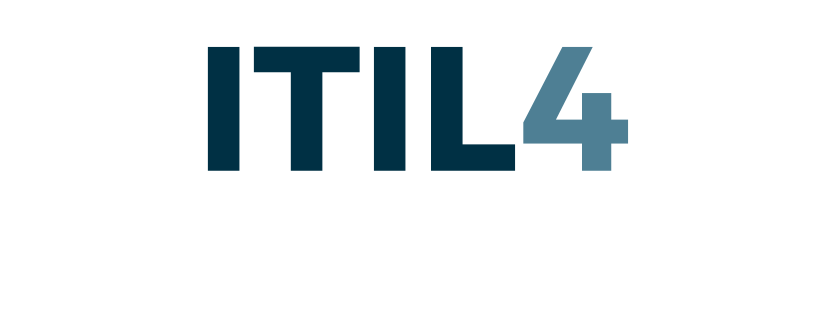ITIL 4 OVERVIEW & POSTERS
…high-velocity adventures
in Service Management universe!
“If everything seems under control, you’re not going fast enough.” – Mario Andretti
SERVICE MANAGEMENT & ITIL
Services are the main way that organizations create value. Today, most services are IT-enabled and IT service management (ITSM) is considered a key strategic capability!
SERVICE MANAGEMENT
Service Management is a set of specialized organizational capabilities for enabling value for customers in the form of services.
ITIL
ITIL is a collection of best practice recommendations for Service Management and most adopted Service Management framework world wide.

WHY ITIL 4?
Service management is evolving, and so is ITIL.
ITIL 4 (2019) is designed to ensure the system for the effective governance and management of IT-enabled services. It is re-shaping established ITSM practices in the wider context of customer experience, value streams, and digital transformation as well as embracing new ways of working, such as Lean, Agile, and DevOps.
ITIL 4 provides the guidance organizations need to address new service management challenges and utilize the potential of modern technology.

KEY CONCEPTS OF ITIL 4 ARE…
4 DIMENSIONS OF SERVICE MANAGEMENT
SERVICE VALUE SYSTEM (SVS)
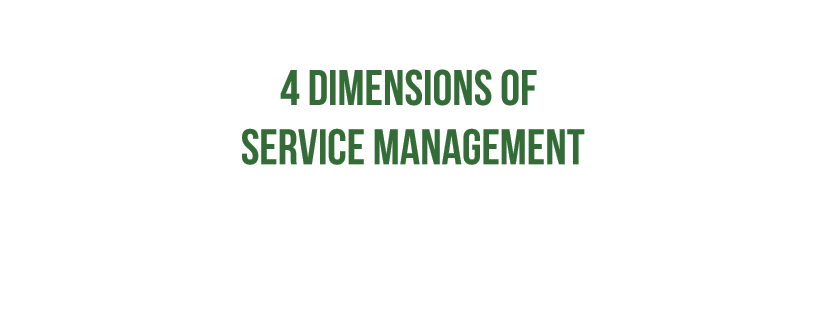
4 DIMENSIONS OF SERVICE MANAGEMENT
…represent relevant Service Management perspectives that should be considered in everything you do!
4 DIMENSIONS OF SERVICE MANAGEMENT
ITIL 4 outlines four dimensions in ensuring a holistic approach to service management:
1. Organisations & People
2. Information & Technology
3. Partners & Suppliers
4. Value Streams & Processes
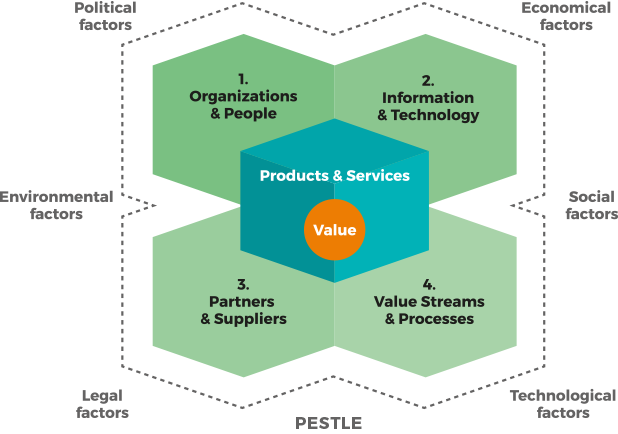
Organization – Ensuring that the way an organization is structured and managed, as well as its roles, responsibilities, and systems of authority and communication, is well defined and supports its overall strategy and operating model.
People (whether customers, employees of suppliers, employees of the service provider, or any other stakeholder in the service relationship) are a key element in this dimension.
In the context of a specific IT service, this dimension includes the information created, managed and used in the course of service provision and consumption, and the technologies that support and enable that service.
The partners and suppliers dimension encompasses an organization’s relationships with other organizations that are involved in the design, development, deployment, delivery, support and/or continual improvement of services. It also incorporates contracts and other agreements between the organization and its partners or suppliers.
Value streams and processes dimension is concerned with how the various parts of the organization work in an integrated and coordinated way to enable value creation through products and services. The dimension focuses on what activities the organization undertakes, and how they are organized, as well as how the organization ensures that it is enabling value creation for all stakeholders efficiently and effectively.
PESTLE model describes factors that constrain or influence how service provider operates.
P – Political factors
E – Economical factors
S – Social factors
T – Technological factors
L – Legal factors
E – Environmental factors
By giving each of the four dimensions an appropriate amount of focus, an organization ensures its Service Value System (SVS) remains balanced and effective.

WHY VALUE STREAMS?
ITIL 2 and ITIL 3 were unintentionally “process siloed”.
ITIL4 introduces Value streams to improve coordination and integration of activities as well as focus on value co-creation. Identifying and understanding the various value streams an organization has is critical to improving its overall performance.
VALUE STREAM
Value stream is a series of steps an organization undertakes to create and deliver products and services to consumers. Value stream is a combination of the organisation’s value chain activities. Value streams define WHAT you do.
PROCESS
Process: A set of interrelated or interacting activities that transform inputs into outputs. A process takes one or more defined inputs and turns them into defined outputs. Processes define the sequence of actions and their dependencies. Processes define HOW is it done.
Structuring the organization’s activities in the form of value streams allows it to have a clear picture of what it delivers and how, and to make continual improvements to its services.
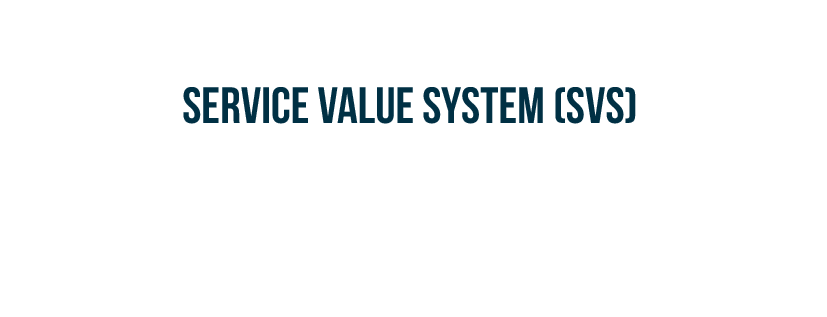
SERVICE VALUE SYSTEM (SVS)
… for service management to function properly, it needs to work as a system.
SERVICE VALUE SYSTEM (SVS)
ITIL SVS describes how all the components and activities of the organization work together as a system to enable value creation.
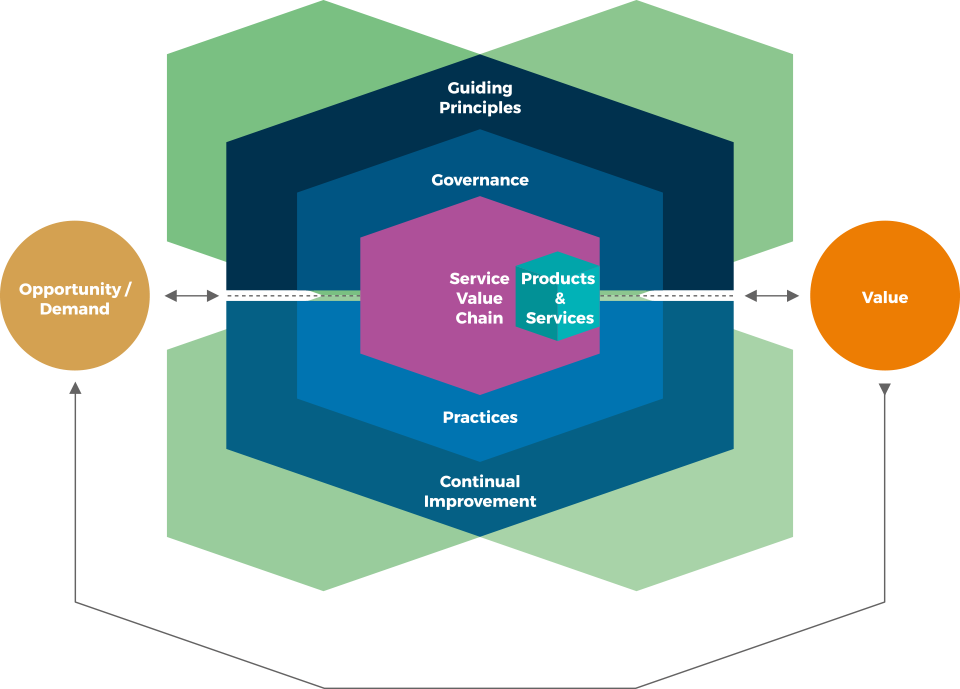
Guiding principles: Recommendations that can guide an organization in all circumstances, regardless of changes in its goals, strategies, type of work, or management structure.
Governance: The means by which an organization is directed and controlled.
Service value chain: A set of interconnected activities that an organization performs to deliver a valuable product or service to its consumers and to facilitate value realization.
Practices: Sets of organizational resources designed for performing work or accomplishing an objective.
Continual improvement: A recurring organizational activity performed at all levels to ensure that an organization’s performance continually meets stakeholders’ expectations.
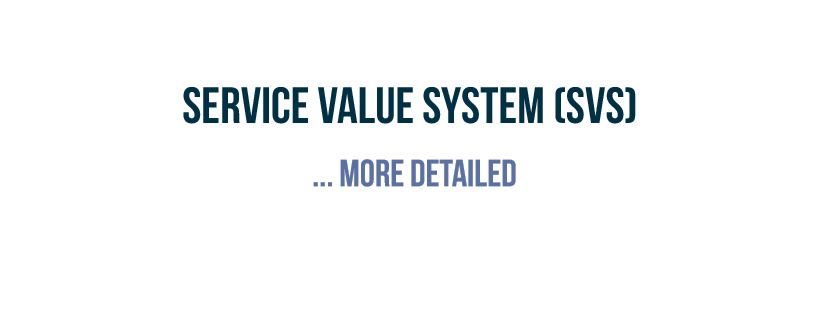
SERVICE VALUE SYSTEM (SVS) – more deatiled
… from OPPORTUNITY/ DEMAND to VALUE …
OPPORTUNITY & DEMAND
PRODUCTS & SERVICES
VALUE
ITIL Service Value System (SVS) enables organizations’ “journey”
from OPPORTUNITY/ DEMAND to achievement of organizational objectives, delivery of SERVICES and finally VALUE co-creation for stakeholders…
… and in order to make this “journey” a successful one, all SVS COMPONENTS must work as a system!…
SVS COMPONENTS
GUIDING PRINCIPLES
GOVERNANCE
SERVICE VALUE CHAIN
PRACTICES
CONTINUAL IMPROVEMENT

OPPORTUNITY & DEMAND
Opportunity and Demand trigger activities within the ITIL SVS, and these activities lead to the creation of value.
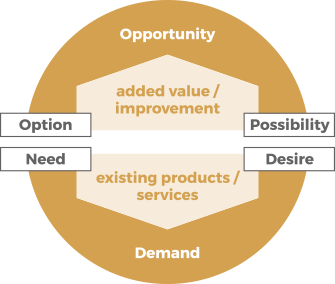
OPPORTUNITY
Opportunities are options or possibilities to add value for stakeholders or otherwise improve the organization.
DEMAND
Demand is a need or desire for products and services among internal and external consumers.

GUIDING PRINCIPLES
Guiding Principles are recommendations that can guide an organization in all circumstances, regardless of changes in its goals, strategies, type of work, or management structure.
ITIL GUIDING PRINCIPLES
…guide organization’s decisions and actions and ensure a shared understanding and common approach to service management across the organization.
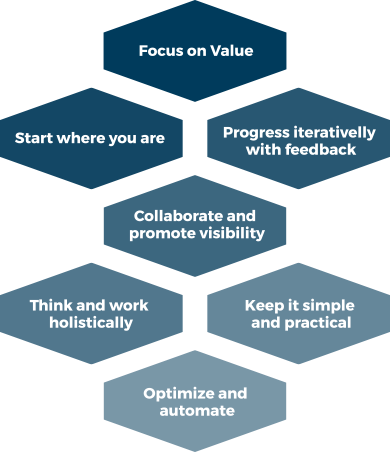
7 GUIDING PRINCIPLES
Everything that the organization does needs to map, directly or indirectly, to value for the stakeholders. The focus on value principle encompasses many perspectives, including the experiences of customers and users.
Do not start from scratch and build something new without considering what is already available to be leveraged. There is likely to be a great deal in the current services, processes, programs, projects and people that can be used to create the desired outcome.
Do not attempt to do everything at once. Even huge initiatives must be accomplished iteratively. By organizing work into smaller, manageable sections that can be executed and completed in a timely manner, it is easier to maintain a sharper focus on each goal.
Working together across boundaries produces results that have greater buy-in, more relevance to objectives and better likelihood of long-term success.
The outcomes achieved by the service provider and service consumer will suffer unless the organization works on the service as a whole, not just on it’s parts.
If a process, service, action or metric provides no value, or produces no useful outcome, eliminate it.
Resources of all types, particularly human resources (HR), should be used to their best effect. Eliminate anything that is truly wasteful and use technology to achieve whatever it is capable of.
GUIDING PRINCIPLES…
… guide organizations as they ADOPT a service management approach.
… guide organization as they ADAPT ITIL guidance to their own specific needs and circumstances.
… encourage and support organizations in CONTINUAL IMPROVEMENT at all levels.
… allow organizations to effectively INTEGRATE THE USE OF MULTIPLE METHODS into an overall approach to service management.

GOVERNANCE
Organizational governance is a system by which an organization is directed and controlled.
Governance is realized though the activities: Evaluate, Direct, Monitor that enable organizations to continually align their operations with the strategic direction set by the governing body.

GOVERNING BODY
Governing body is a person or group of people who are accountable at the highest level for the performance and compliance of the organization.

SERVICE VALUE CHAIN
Service value chain is an operating model which outlines the key activities required to respond to demand and facilitate value creation through the creation and management of products and services.
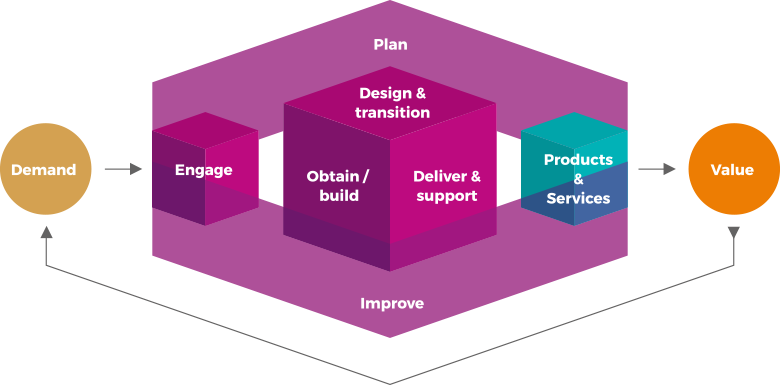
ITIL service value chain includes six value chain activities.

SERVICE VALUE CHAIN ACTIVITIES
PLAN
ensures a shared understanding of the vision, current status and improvement direction for all four dimensions and all products and services across the organization.

IMPROVE
ensures continual improvement of products, services and practices across all value chain activities and the four dimensions of service management.
ENGAGE
provides a good understanding of stakeholder needs, transparency, and continual engagement and good relationships with all stakeholders.

DESIGN & TRANSITION
ensures that products and services continually meet stakeholder expectations for quality, costs and time-to-market.
OBTAIN/BUILD
ensures that service components are available when and where they are needed, and meet agreed specifications.

DELIVER & SUPPORT
ensures that services are delivered and supported according to agreed specifications and stakeholders’ expectations.
Each activity may draw upon internal or third party resources, processes, skills and competencies from one or more practices….

PRACTICES
Sets of organizational resources designed for performing work or accomplishing an objective. These resources are grouped into the four dimensions of service management.
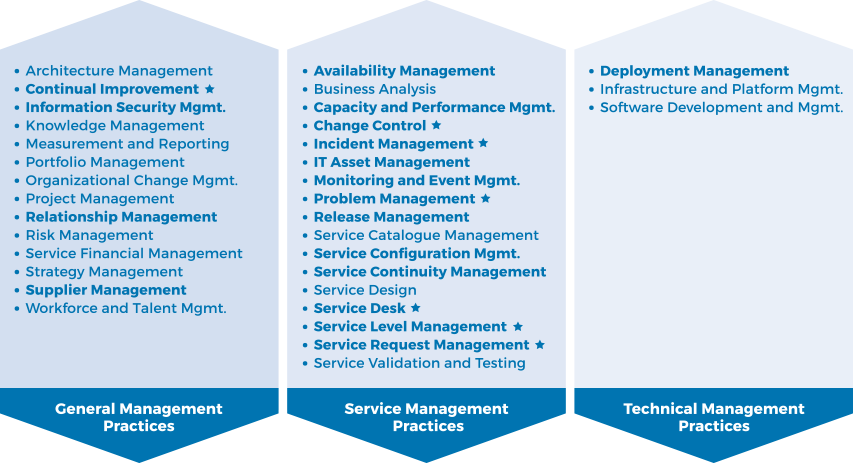

GENERAL MANAGEMENT PRACTICES
The purpose of the architecture management practice is to provide an understanding of all the different elements that make up an organization and how those elements interrelate.
This supports the organization in effectively achieving its current and future objectives. These elements span all architecture domains: business, service, information, technology, and the environment. Architecture management provides the principles, standards and tools that enable an organization to manage complex change in a structured and agile way to execute its strategy.
The purpose of the continual improvement practice is to align the organization’s practices and services with changing business needs through the ongoing identification and improvement of services, service components, practices or any element involved in the efficient and effective management of products and services.
The purpose of the information security management practice is to protect the information needed by the organization to conduct its business.
This includes understanding and managing risks to the confidentiality, integrity and availability of information, as well as other aspects of information security such as authentication (ensuring someone is who they claim to be), and non-repudiation (ensuring that someone can’t deny that they took an action).
The purpose of the knowledge management practice is to maintain and improve the effective, efficient and convenient use of information and knowledge across the organization.
The purpose of the measurement and reporting practice is to support good decision – making and continual improvement by decreasing levels of uncertainty. This is achieved through the collection of relevant data on various managed objects and the valid assessment of this data in an appropriate context. Managed objects include, but are not limited to, products and services, practices and value chain activities, teams and individuals, suppliers and partners, and the organization as a whole.
The purpose of the organizational change management practice is to ensure that changes in an organization are smoothly and successfully implemented and that lasting benefits are achieved by managing the human aspects of the changes.
The purpose of the portfolio management practice is to ensure that the organization has the right mix of programmes, projects, products and services, to execute the organization’s strategy within its funding and resource constraints.
The purpose of the project management practice is to ensure that all projects in the organization are successfully delivered. This is achieved by planning, delegating, monitoring and maintaining control of all aspects of a project, and keeping the motivation of those involved.
The purpose of the relationship management practice is to establish and nurture the links between the organization and its stakeholders at strategic and tactical levels. It includes the identification, analysis, monitoring and continual improvement of relationships with and between stakeholders.
The purpose of the risk management practice is to ensure that the organization understands and effectively handles risks.
The purpose of the service financial management practice is to support the organization’s strategies and plans for service management by ensuring that organization’s financial resources and investments are being used effectively.
Service financial management supports decision making by the governing body and management of the organization regarding where to best allocate financial resources and provides visibility into the budgeting, costing, accounting activities related to the products and services.
The purpose of the strategy management practice is to formulate the goals of the organization and adopt the courses of action and allocation of resources necessary for carrying out those goals. Strategy establishes the organization’s direction, focuses effort, defines or clarifies the organization’s priorities, and provides consistency or guidance in response to the environment.
The purpose of the supplier management practice is to ensure that the organization’s suppliers and their performance are managed appropriately to support the provision of seamless, quality products and services. This can include creating closer, more collaborative relationships with key suppliers to uncover and realize new value and reduce risk of failure.
The purpose of the workforce and talent management practice is to ensure that the organization has the right people with the appropriate skills and knowledge and in the correct roles to support its business objectives. The practice covers a broad set of activities focused on successfully engaging with the organization’s employees and people resources including planning, recruitment, on-boarding, learning and development, performance measurement and succession planning.

SERVICE MANAGEMENT PRACTICES
The purpose of the availability management practice is to ensure that services deliver agreed levels of availability to meet the needs of customers and users.
The purpose of the business analysis practice is to analyze a business or some element of a business, define its associated business needs and recommend solutions to address these needs and/or solve a business problem, which must facilitate value creation for stakeholders. Business analysis enables an organization to communicate its needs in a meaningful way, express the rationale for change, and design and describe solutions that can enable value creation in alignment with the organization’s objectives.
The purpose of the capacity and performance management practice is to ensure that services achieve agreed and expected performance, satisfying current and future demand in a cost-effective way.
The purpose of the change control practice is to maximize the number of successful IT changes by ensuring that risks have been properly assessed, authorizing changes to proceed, and managing a change schedule.
The purpose of incident management is to minimize the negative impact of incidents by restoring normal service operation as quickly as possible.
The purpose of the IT asset management practice is to plan and manage the full lifecycle of all IT assets, to help the organization:
- Maximize value
- Control costs
- Manage risks
- Support decision-making about purchase, reuse and retirement of assets
- Meet regulatory and contractual requirements.
The purpose of the monitoring and event management practice is to systematically observe services and service components, and record and report selected changes of state identified as events. This practice identifies and prioritises infrastructure, services, business processes and information security events, and establishes the appropriate response to those events, including responding to conditions that could lead to potential faults or incidents.
The purpose of problem management is to reduce the likelihood and impact of incidents by identifying actual and potential causes of incidents, and managing workarounds and known errors.
The purpose of the release management practice is to make new and changed services and features available for use.
The purpose of service catalogue management is to provide a single source of consistent information on all services and service offerings, and to ensure that it is available to the relevant audience.
The purpose of the service configuration management practice is to ensure that accurate and reliable information about the configuration of services, and the CIs that support them, is available when and where it is needed. This includes information on how CIs are configured and the relationships between them.
The purpose of the service continuity management practice is to ensure that the availability and performance of a service is maintained at a sufficient level in the event of a disaster. The practice provides a framework for building organizational resilience with the capability of producing an effective response that safeguards the interests of key stakeholders, and the organization’s reputation, brand and value-creating activities.
The purpose of the service design practice is to design products and services that are fit for purpose, fit for use and that can be delivered by the organization and its ecosystem. This includes planning and organizing people, partners and suppliers, information, communication, technology and practices for new or changed products and services, and the interaction between the organization and its customers.
The purpose of the service desk practice is to capture demand for incident resolution and service requests. It should also be the point of communication for the service provider with all of its users. In other words, it should act as the entry point/single point of contact for the IT or service organization.
The purpose of the service level management practice is to set clear business-based targets for service performance, so that the delivery of a service can be properly assessed, monitored and managed against these targets.
The purpose of the service request management practice is to support the agreed quality of a service by handling all pre-defined, user-initiated service requests in an effective and user-friendly manner.
The purpose of the service validation and testing practice is to ensure that new or changed products and services meet defined requirements. The definition of service value is based on input from customers, business objectives and regulatory requirements, and is documented as part of the value chain activity of design and transition. These inputs are used to establish measurable quality and performance indicators that support the definition of assurance criteria and testing requirements.

TECHNICAL MANAGEMENT PRACTICES
The purpose of the deployment management practice is to move new or changed hardware, software, documentation, processes, or any other component to live environments. It may also be involved in deploying components to other environments for testing or staging.
The purpose of the infrastructure and platform management practice is to oversee the infrastructure and platforms used by an organization. When carried out properly, this practice enables the monitoring of technology solutions available to the organization, including the technology of external service providers.
The purpose of the software development and management practice is to ensure that applications meet internal and external stakeholder needs, in terms of functionality, reliability, maintainability, compliance and auditability.

CONTINUAL IMPROVEMENT
Continual improvement is a recurring organizational activity performed at all levels to ensure that an organization’s performance continually meets stakeholders’ expectations.

ITIL CONTINUAL IMPROVEMENT MODEL
ITIL continual improvement model provides organizations with a structured approach to implementing improvements.
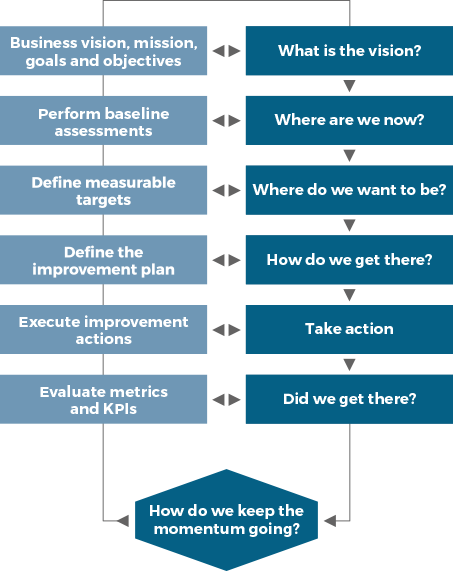
The continual improvement model applies to the SVS in its entirety, as well as to all of the organization’s products, services, service components and relationships.

PRODUCTS & SERVICES
SERVICE
Service is a means of enabling value co-creation by facilitating outcomes that customers want to achieve, without the customer having to manage specific costs and risks.
PRODUCT
A configuration of an organization’s resources designed to offer value for a consumer.
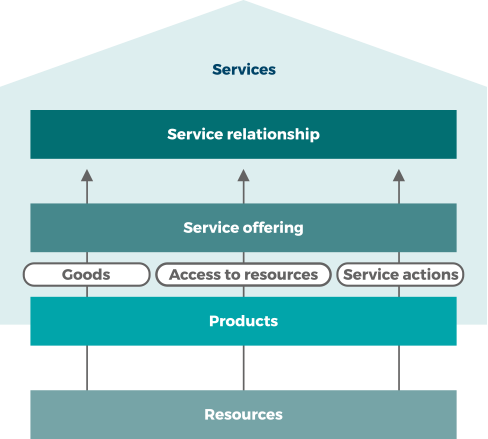
SERVICE OFFERING
A description of one or more services, designed to address the needs of a target consumer group. A service offering may include goods, access to resources, and service actions.
SERVICE RELATIONSHIP
A co-operation between a service provider and service consumer. Service relationships include service provision, service consumption and service relationship management.

VALUE
Value is the perceived benefits, usefulness and importance of something.
Service relationships are perceived as valuable only when they have more positive effects than negative.

NEGATIVE EFFECTS
Service relationships can introduce new risks and costs, and in some cases, can negatively affect some of the intended outcomes, while supporting others.

POSITIVE EFFECTS
Service providers help their consumers to achieve outcomes, and in doing so, take on some of the associated risks and costs.

OUTCOME, COST & RISK

OUTCOME
Outcome is a result for a stakeholder enabled by one or more outputs.

COST
Cost is the amount of money spent on a specific activity or resource.

RISK
A possible event that could cause harm or loss, or make it more difficult to achieve objectives.
… or uncertainty of outcome.

UTILITY & WARRANTY
From the customer’s perspective, value consists of two primary elements: utility (fitness for purpose) and warranty (fitness for use).

UTILITY
‘what the service does’
The functionality offered by a product or service to meet a particular need. Utility can be summarized as ‘what the service does’ and can be used to determine whether a service is ‘fit for purpose’. To have utility, a service must either support the performance of the consumer or remove constraints from the consumer. Many services do both.

WARRANTY
‘how the service performs’
Assurance that a product or service will meet agreed requirements. Warranty can be summarized as ‘how the service performs’ and can be used to determine whether a service is ‘fit for use’. Warranty often relates to service levels aligned with the needs of service consumers.


